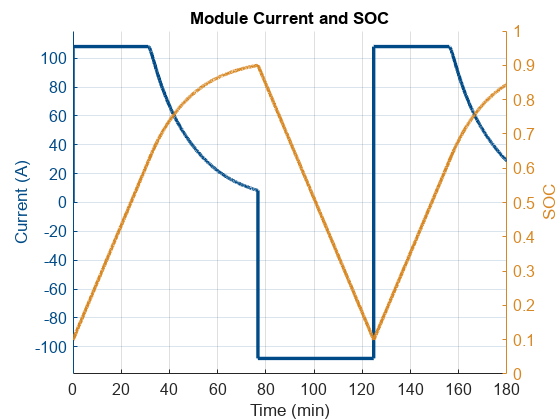Perform Controlled Charging and Discharging on Battery Module
This example shows how to perform a cyclic charge and discharge profile on a battery module by using the Battery CC-CV block. At the start of the simulation, the battery module has a state of charge (SOC) of 10%. The Battery CC-CV block performs a constant-current (CC) charging until it reaches the limit cell voltage of 4.1 V specified in the Maximum cell voltage (V) parameter. The block then charges the battery with a constant-voltage (CV) profile until the module SOC reaches 90%. Finally, the block starts a CC discharging procedure and discharges the module until the SOC reaches the initial value of 10%. The charge and discharge cycle then restarts.
Model Overview
Open the controlledCharging model.
modelname = "controlledCharging";
open_system(modelname);
The model comprises a pre-generated Module block and a Battery CC-CV block. The Module block represents a battery module with three parallel assemblies with a gap between each parallel assembly of 0.5 mm, a detailed model resolution, and an enabled ambient thermal path. Each parallel assembly comprises four single-stacked pouch cells. Each pouch cell measures 300 mm in length, 100 mm in height, and 10 mm in thickness. For more information on how to generate the Module block, open the controlledChargingCreatelib.mlx file.
Run the simulation.
ssc_cntrlChrg = sim(modelname);
Simulation Results
This plot shows the current and the state of charge of the battery module during the simulation. The Battery CC-CV block charges the battery module from 10% to 90% in around 75 minutes. Then, the block discharges the battery module back to an SOC of 10% before charging it back again to 90%.
controlledChargingPlotSOC;

See Also
Module (Generated
Block) | batteryModule | Battery CC-CV